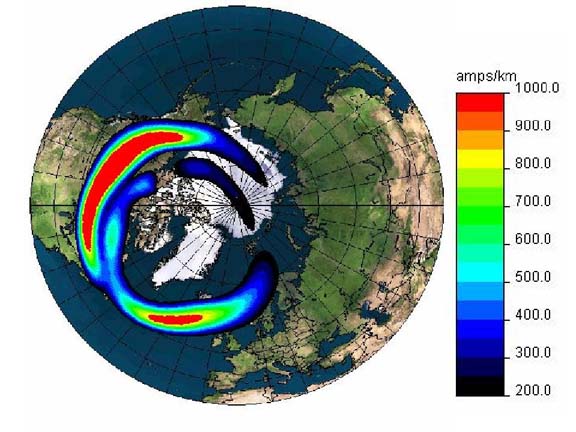
Contact: Christine Hopf-Lovette, EPRI, (650) 855-2733, chopf@epri.com
For Immediate Release
New Technology Protects Power Systems from Effects of Solar Storms
Monitoring and forecasting system provides advance warning of potential damage to generating plants and transmission grids
Palo Alto, Calif. —June 15, 1999—Solar storms are back! Solar Cycle 23, the next 11-year cycle of solar activity and geomagnetic disturbances, has begun, and its peak period is expected in the first quarter of 2000. This time, however, power companies in danger of impact from the solar storms’ geomagnetically induced currents can receive enough advance warning to protect their systems.
EPRI, the science and technology development organization for the power industry, has worked with Metatech Applied Power Solutions of Duluth, Minn. and the UK’s National Grid to combine EPRI’s SUNBURST 2000 real-time monitoring equipment with Metatech’s SpaceCast/PowerCast(TM) geomagnetic storm forecasting services.
Soon after installation was completed in early May, the first client for the sophisticated new system, National Grid, began receiving forecasts of transmission system impacts approximately 45 minutes prior to the event—long enough to allow the transmission system operator to take precautionary actions. With the second phase of the installation later this summer, EPRI’s SUNBURST 2000 monitoring equipment will begin to provide real-time observations of geomagnetic disturbances and the impacts of those disturbances on the National Grid’s transmission system.
"An important element in our strategy for dealing with solar storms is to provide early warning to our system operators," said National Grid’s senior consultant, Arslan Erinmez. "Since the last major storms of 1989 and 1991, significant developments in the means of accurate prediction have given us an increased understanding of the phenomena. We are now able to produce early-warning forecasts that are specific to our own transmission system, and our operators can take appropriate actions to manage any potential loss in the quality of supply."
During solar storms, enormous flares of energy on the sun’s surface hurl dense waves of protons and electrons through space. The charged particles reach the earth several days later, interacting with and shifting the earth’s magnetic field, which in turn induces large currents that circulate in the earth. The resulting currents can enter power systems and disrupt and damage equipment. On March 13, 1989, for instance, a very strong geomagnetic disturbance collapsed Hydro Quebec’s electric transmission system. Six million people were without commercial electric power for nine hours. On that same date, a major bank of transformers at the Salem nuclear plant in New Jersey was irreparably damaged.
According to Bill Feero of Electric Research and Management Inc., in State College, Penn., EPRI’s collaborator on SUNBURST, new high-speed communication links in SUNBURST 2000 will monitor various regions of the world and provide participants with readings within seconds. "This is enough time to desensitize the system and adjust loading before the impact of the storm occurs," Feero noted.
In 1991, EPRI and cooperating US and Canadian utilities installed the SUNBURST monitoring system to collect data on the characteristics and effects of geomagnetically induced currents (GIC) in electric power substations and generating plants across North America.
"The immediate impact of GIC on power systems is to cause half-cycle saturation of most of the power transformers through which the GIC flows, says Ben Damsky, EPRI’s manager for power electronic systems. "SUNBURST data has shown that unusual harmonics with extremely high amplitude which result from half-cycle saturation can disrupt the power system’s operation, damage generators, and may generate inappropriate trip signals."

The electrojet current structure, which is a result of geomagnetic storm conditions, enlarges and spreads dramatically as the storm increases in severity, erupting on a global scale within minutes.
Predictive models of the magnetosphere and ionosphere and data from a satellite positioned in the solar wind about one million miles upstream of the earth are used to forecast the movement of the electrojet current and the impact of its storm. Because communications travel faster than solar wind, solar storm onsets can be predicted typically 45 minutes to an hour in advance.
In May 1998, a small, intense storm struck the NE corner of the US, putting Bangor Hydro-Electric Co. and Central Maine Power Co. in an insecure position for
one half hour. Based on this and other solar observations, NOAA (National Oceanic and Atmospheric Administration) scientists have predicted that Solar Cycle 23 will be at least as strong as Cycle 22, which produced the Hydro Quebec and Salem damage.
Severe geomagnetic storm conditions can erupt within a few minutes on a planetary scale," says John Kappenman, division manager for Metatech. "This combination of technologies provides transmission system operators with specifically tailored forecasts in time to take appropriate action."
For more information on power company participation in the solar storm monitoring and forecasting program, contact Ben Damsky, EPRI, at (650) 855-2733; bdamsky@epri.com. or Ray Lings, EPRI at (650) 855-2177; lings@epri.com.
EPRI, established in 1973 and headquartered in Palo Alto, Calif., manages science and technology projects for the energy and energy services industry worldwide.
Illustration available. Contact Christine Hopf-Lovette, EPRI, (650) 855-2733 or chopf@epri.com